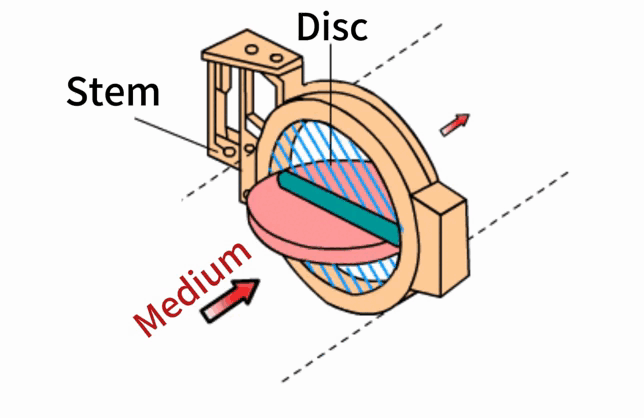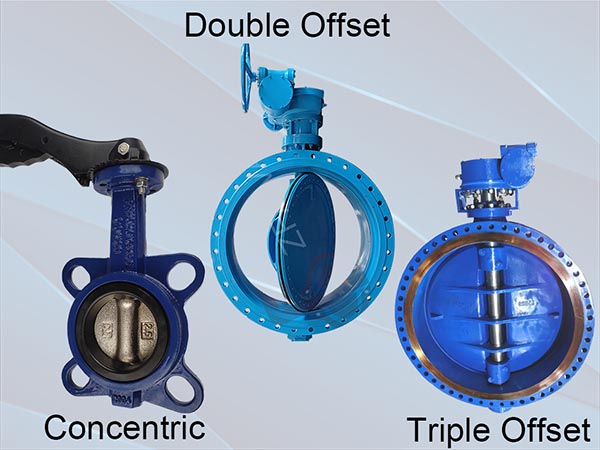1. What is a butterfly valve?
1.1 Introduction to butterfly valves
Butterfly valves play a vital role in fluid control systems. These valves manage the flow of liquids and gases in pipelines. The simple design, quick response and low price of butterfly valves are very attractive.
Common applications of butterfly valves cover various fields. Water supply systems often use these butterfly valves. Wastewater treatment plants also rely on them. The oil and gas industry has a high demand for stainless steel butterfly valves. Fire protection systems and chemical industries also benefit from their use. Power generation facilities often incorporate butterfly valves into their operations.
 1.2 Basic components
1.2 Basic components
Butterfly valves are composed of several key components. Each component is integral in the function of the valve.
Valve body
The valve body can be understood as the outer shell of the butterfly valve, which houses all other components. This component is installed between the pipe flanges.
Disc
The disc acts as a gate inside the valve and is a fluid control component. This component rotates to control the fluid flow. The rotation of the disc determines whether the valve is open or closed.
seat
The valve seat is superimposed on the valve body and provides a seal for the valve disc in the closed state. The valve seat can be made of a variety of materials, such as rubber, metal, or a combination of both, depending on the application.
Stem
The valve stem connects the disc to the actuator. This component transmits motion to the disc. Rotation of the stem controls the rotation of the disc.
Actuator
The actuator can be manual (handle or worm gear), pneumatic, or electric, depending on the level of automation required.
2. What does a butterfly valve do? How does a butterfly valve work?
2.1 Quarter-turn rotational motion
Butterfly valves use a quarter-turn rotational motion. Rotating the disc 90 degrees opens or closes the valve. This is the fast response mentioned above. This simple action makes butterfly valves ideal for applications that require quick adjustments.
The advantages of this motion are many. The design ensures fast operation, which is crucial in situations where frequent valve changes are required. The compactness of butterfly valves also saves space and reduces installation costs. You will find these valves cost-effective and easy to maintain.
2.2 Operation process
The operation process of a butterfly valve is simple. You open the valve by turning the actuator to position the disc parallel to the direction of water flow. This position allows fluid to pass through with minimal resistance. To close the valve, you turn the disc perpendicular to the direction of the water flow, which creates a seal and blocks the flow.
3. Types of Butterfly Valves
There are many types of butterfly valves, each designed for specific applications and installation conditions.
3.1 Concentric Butterfly Valves
The design of the concentric butterfly valve is very simple. The disc and seat are aligned along the centerline of the valve. The seat of the concentric butterfly valve is made of elastic material, so it is only suitable for low-pressure applications. You often see concentric butterfly valves in water supply systems.
3.2 Double eccentric (high-performance) butterfly valves
Double eccentric butterfly valves perform better. The disc is offset from the centerline of the valve, reducing wear on the disc and seat and improving the seal. This design is suitable for high pressure. Double eccentric valves are often used in industries such as oil and gas.
3.3 Triple eccentric butterfly valves
Triple eccentric butterfly valves have excellent sealing capabilities. Based on the double eccentric butterfly valve, the offset of the seat constitutes a third offset, minimizing contact with the seat during operation. This design extends the service life of the entire butterfly valve and ensures a tight seal. You’ll find triple eccentric valves in critical applications where zero leakage is required at high temperatures and pressures.
4. Features and Benefits of Butterfly Valves4.1 Features of Butterfly Valves
Butterfly valves open or close with a simple 90-degree turn. This design allows for quick operation, making it ideal for situations where quick adjustments are required. The mechanism ensures that the valve opens with minimal resistance, providing effective flow control.
Butterfly valves also offer a variety of benefits. You’ll find them easy to operate due to their low torque requirements. This feature makes actuator size and installation cheaper. The design also reduces wear on valve components, increasing service life and reliability.
Other valves, such as gate valves, typically have higher pressure drops and require more maintenance. And you may find that gate valves are less suitable for rapid and frequent operations, a point that has been mentioned elsewhere. Butterfly valves excel in these areas, making them a popular choice for many industries.
4.2 Comparison with other valves
When comparing butterfly valves to other types of valves, you’ll notice a few key differences.
4.2.1 Small footcover
Butterfly valves are more compact, lightweight, and have a short structural length, so they fit in any space.
4.2.2 Low Cost
Butterfly valves use less raw materials, so the raw material cost is usually lower than other valves. And the installation cost is also low.
4.2.3 Lightweight Design
The butterfly valve is lightweight because it offers a variety of material options. You can choose butterfly valves made of durable materials such as ductile iron, WCB or stainless steel. These materials have excellent corrosion resistance. The lightweight nature of the material also makes it easier to operate and install.
Lightweight design significantly affects installation. Butterfly valves are easier to install due to their reduced size and weight. This feature minimizes the need for heavy lifting equipment.
4.2.4 Cost-effective
Butterfly valves are the most cost-effective choice for fluid control. The butterfly valve has fewer internal groups, requires less material and labor to produce, and has reduced maintenance expenses, which reduces the overall cost. You will find that butterfly valves are an economical choice for initial investment and long-term operation.
4.2.5 Tight sealing
Tight sealing is an outstanding feature of butterfly valves. The safe seal maintains system integrity and prevents fluid loss.
The disc and seat work together to form a perfect 0 leakage. In particular, triple offset butterfly valves ensure that the valves operate efficiently even at high pressures.
5. Versatility of butterfly valve applications
Butterfly valves shine because of their versatility. They can be found wherever reliable fluid control is needed.
Butterfly valves serve a wide range of industries. Water supply systems, sewage treatment plants benefit from their reliability. The oil and gas industry relies on butterfly valves to handle different fluids. Fire protection systems use butterfly valves for quick response. The chemical industry uses them to precisely control hazardous materials. Power generation facilities rely on butterfly valves for smooth operation.
These examples show how butterfly valves meet the different needs of various industries. You can trust butterfly valves to provide reliable performance in any application.
6. Advantages of using ZFA butterfly valves
6.1 Reduced costs
The cost advantage of ZFA butterfly valves does not mean reducing the use of materials. Instead, it uses a stable supplier of raw materials, rich production experience, and a mature production system to reduce labor costs.
6.2 Long-term financial advantages
The materials used in ZFA butterfly valves are genuine, with thicker valve bodies, pure natural rubber valve seats, and purer stainless steel valve stems. This ensures a longer service life and minimizes the need for replacement. It not only helps you reduce maintenance requirements, but also reduces ongoing operating costs.
6.3 Perfect after-sales service
Zfa butterfly valve manufacturers provide a warranty period of up to 18 months (starting from the date of shipment).
6.3.1 Warranty period
Our butterfly valve products enjoy a 12-month quality guarantee from the date of purchase. During this period, if the product is found to be faulty or damaged due to material or manufacturing process problems, fill out the service form (including invoice number, problem description and related photos), and we will provide free repair or replacement service.
6.3.2 Technical support
We provide remote technical support, including product installation guidance, operation training and maintenance recommendations. We will respond within 24 hours.
6.3.3 On-site service
In special circumstances, if on-site support is required, our technicians will arrange a trip as soon as possible.
Media Contact
Company Name: Tianjin Zhongfa Valve Co., Ltd.
Email: Send Email
Phone: +86 13212024235
Address:No.38, Baoyuan Road, Jinnan Economic Development Zone, Jinnan District
City: Tianjin
Country: China
Website: https://www.zfavalve.com/

















